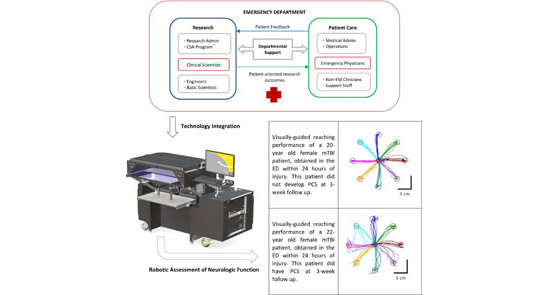
This paper demonstrates the effective deployment of a robotic assessment tool for evaluation of mild Traumatic Brain Injury patients in a busy, resource-constrained, urban Emergency Department (ED). Over 14 months, 1423 patients were screened and 42 of them completed both robot-assisted testing and follow-up assessment. Successful completion of screening and enrollment demonstrated that the challenges associated with integration of investigational devices into the ED can be effectively addressed through a collaborative patient-oriented research model. Integration of this technology into the ED serves as an important step towards pursuing active clinical research in an acute care setting.
The objective of this paper is to demonstrate the effective deployment of a robotic assessment tool for the evaluation of mild traumatic brain injury (mTBI) patients in a busy, resource-constrained, urban emergency department (ED). Methods: Functional integration of new robotic technology for research in the ED presented several obstacles that required a multidisciplinary approach, including participation from electrical and computer engineers, emergency medicine clinicians, and clinical operations staff of the hospital. Our team addressed many challenges in deployment of this advanced technology including: 1) adapting the investigational device for the unique clinical environment; 2) acquisition and maintenance of appropriate testing space for point-of-care assessment; and 3) dedicated technical support and upkeep of the device. Upon successful placement of the robotic device in the ED, the clinical study required screening of all patients presenting to the ED with complaints of head injury. Eligible patients were enrolled and tested using a robot-assisted test battery. Three weeks after the injury, patients were contacted to complete follow-up assessments. Results: Adapting the existing technology to meet anticipated physical constraints of the ED was performed by engineering a mobile platform. Due to the large footprint of the device, it was frequently moved before ultimately being fully integrated into the ED. Over 14 months, 1423 patients were screened. Twenty-eight patients could not be enrolled because the device was unavailable due to operations limitations. Technical problems with the device resulted in failure to include 20 patients. A total of 66 mTBI patients were enrolled and 42 of them completed both robot-assisted testing and follow-up assessment. Successful completion of screening and enrollment demonstrated that the challenges associated with integration of investigational devices into the ED can be effectively add- essed through a collaborative patient-oriented research model. Conclusion: Effective deployment and use of new robotic technology for research in an urban academic ED required significant planning, coordination, and collaboration with key personnel from multiple disciplines. Clinical Impact: A pilot clinical study on mTBI patients using the robotic device provided useful data without disrupting the ED workflow. Integration of this technology into the ED serves as an important step toward pursing active clinical research in an acute care setting.

